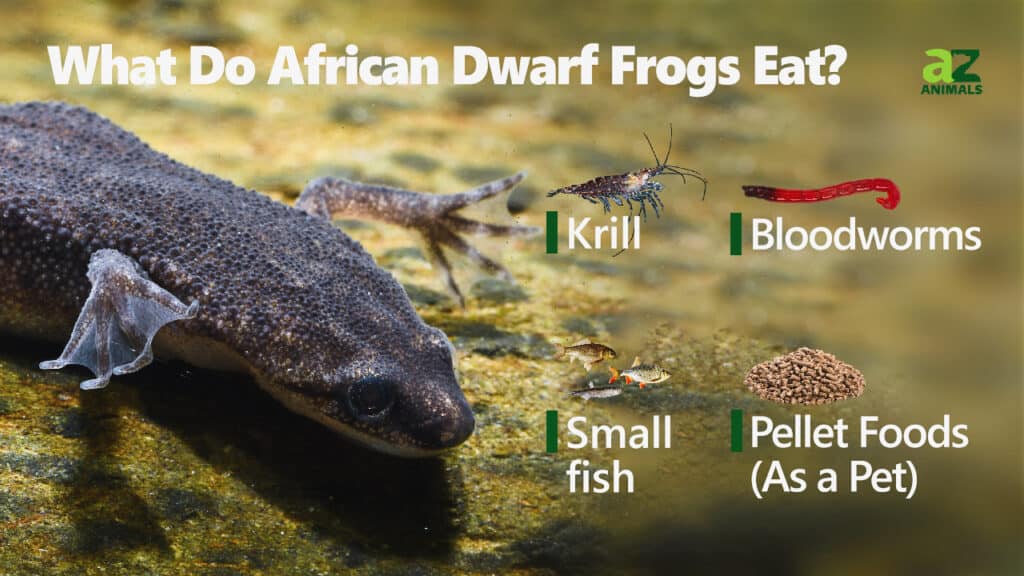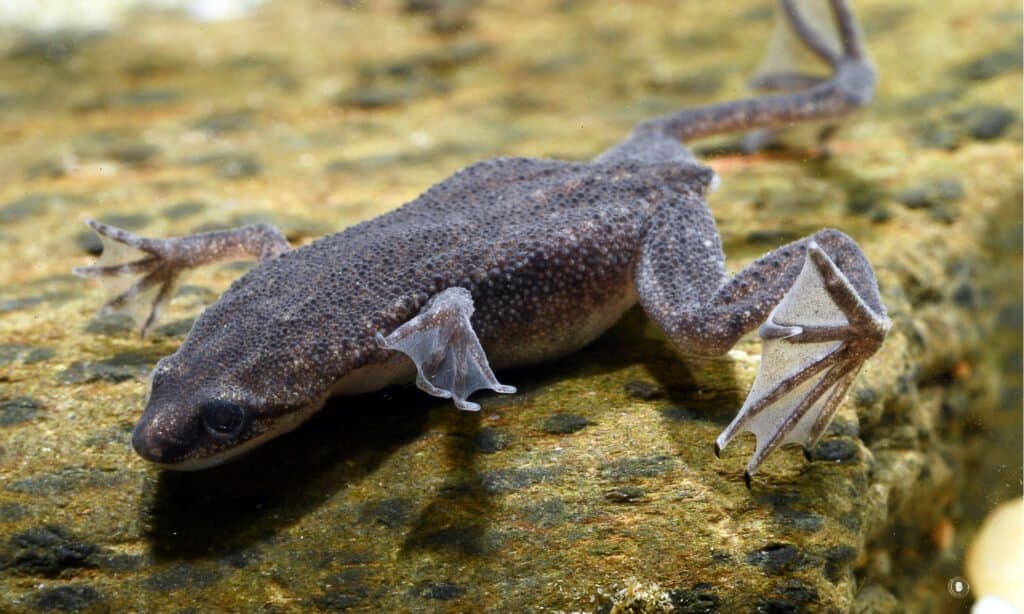African dwarf frogs are a group of species within the same family as the African clawed frogs, but they are significantly smaller and less aggressive. This makes them a very popular choice for aquarium owners. These amphibians have a rather interesting diet. But what do they eat, and how does their diet differ in the wild and as pets? Let’s find out!
What Do African Dwarf Frogs Eat?

In the wild, African dwarf frogs eat a diet of krill, bloodworms, and small fish. As omnivores, they often prefer a mix of live prey and organic matter.
Unlike the African clawed frog, the African dwarf frog is not classified as carnivorous. It’s an omnivore, and a scavenger often referred to as a bottom-feeder. It has a similar diet to many shrimp species, meaning that it can consume almost any plant or animal matter that fits into its mouth. The African dwarf frog is generally able to consume anything living or dead and organic matter.
As these frog species are also scavengers, they can also consume most organic matter they come across. African dwarf frogs can eat the dead of other animals, plants, fungi, and other detritus found in or around their habitats. While they are considered fairly communal types of frogs, they will eat another dead member of their species.
What Do You Feed African Dwarf Frog As Pets?
When keeping African dwarf frogs in an aquarium, they require a diet of both food pellets and target feeding. Food pellets should be either sinking carnivorous fish pellets or pellets specifically formulated for African dwarf frogs to supply proper nutrition.
Target feeding of thawed frozen prey keeps African dwarf frogs healthy. Frozen bloodworms, blackworms, tubifex worms, and brine shrimp are the most recommended target foods and should be thawed and rinsed in freshwater beforehand. Target feeding should only be done once a day.
Any food given to the frogs should remain in the tank for one or two minutes before being removed from the tank. They can consume the amount of food they require well within this period. Removing excess food from the tank keeps them from becoming ill and limits the likelihood of overeating. It is also worth mentioning that removing the excess also makes it easier to clean the tank.
What Do African Dwarf Frog Tadpoles Eat?

African dwarf tadpoles feed on algae, plankton, or other detritus.
©Guillermo Guerao Serra/Shutterstock.com
African dwarf frogs tadpoles eat smaller organic matter such as algae, plankton, or other small detritus during the tadpole phase. As the tadpoles approach adulthood, they progress to larger insects, worms, and larvae. They are communal and do not cannibalize their species.
How Does The African Dwarf Frog Hunt?
Like many frog species, African dwarf frogs do not have teeth or tongues. They use a special organ called a hypobranchial pump to draw or suck food into their mouths. They also use their front feet to push or shove food into their mouths and shred larger food into pieces with their claws. Their highly sensitive feet help them scavenge, and their powerful legs allow them to move swiftly to capture prey.
African dwarf frogs also have lateral lines down the sides and underside of their bodies to compensate for lack of hearing. These frogs don’t have ears, and they use these sensory lines to detect movement and vibration. They rely on these lateral lines and sensitive feet, as well as their sense of smell, to detect prey or to scavenge.
Does The African Dwarf Frog Diet Change By Season?

The African dwarf frog consumes a large amount of food in the wet season.
©Ltshears / Public Domain – License
In the wild, the four species of African dwarf frogs are found in habitats throughout equatorial Africa. They live in shallow freshwater ponds, streams, and rivers found in the forest. During the dry season between late June to September, they stick to these safe habitats.
They travel into flooded areas in the surrounding forest in the two wet seasons. These wet seasons consist of a long period between April to early June and a sporadic period between October and December.
African dwarf frogs consume large amounts of food in wet seasons to sustain themselves in the dry season. During the dry period, they are largely inactive and burrow into the damp mud to wait it out. As these species are largely aquatic, they need to keep their skin moist to avoid the risk of dehydration. By staying beneath the wet mud, they can avoid this risk in Africa’s most severe drought conditions.
What Animals Prey On African Dwarf Frogs?
As the name implies, the African dwarf frog is one of the smallest types of frog. This makes it prime prey for a multitude of larger animals. Predators include carnivorous fish species such as piranhas and larger amphibians like the African Clawed frog. It is also prey for reptiles like snakes and lizards and birds such as owls and storks. Possible predators could even be larger animals like alligators.
The photo featured at the top of this post is © Charlie Tyack/Shutterstock.com
Thank you for reading! Have some feedback for us? Contact the AZ Animals editorial team.






